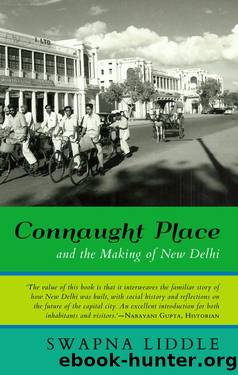Connaught Place and the Making of New Delhi by Swapna Liddle

Author:Swapna Liddle [Liddle, Swapna]
Language: eng
Format: epub
ISBN: 9789388326018
Published: 2018-11-15T08:00:00+00:00
Viceroyâs House, now Rashtrapati Bhavan
The drum and the roofline below the dome had additional features that were Indian, but unusually executed. Lutyens had more than once expressed his impatience with chhatrisâIndian cupolas supported on pillars, on one occasion calling them âstupid, useless things.â When called upon to use them nevertheless, he did so innovatively; thus the chhatris around the dome were built close to the drum, barely breaking its silhouette. Those along the parapet were pushed down into it, so as not to break the roofline too abruptly. On the rooftop were water fountains shaped like saucers, reminiscent of Mughal architecture, which had incorporated water channels and pools in buildings as well as gardens. Below the parapet was a deep chhajja or overhanging cornice, an important feature for the provision of shade in Indian buildings. Its installation during 1926-27 had been beset with technical difficulties.
In contrast to these Indian forms, the long colonnade with its tall columns, which made up the facade of the building, was strictly Western in its form. Each pillar was surmounted by a capital in an unusual styleâencased with abstract acanthus leaves, with four bells at the corners. This style of pillar capital was specially designed by Lutyens, and is known as the âDelhi Orderââafter the Classical Greek OrdersâDoric, Ionic and Corinthian. This capital was used in several other structures designed by Lutyens for New Delhiâsuch as the canopy that would be built later near the War Memorial Arch, and the Record Office.
Though the overall finish of the building was restrained, decorative touches were added through carvings of mainly Indian motifsâsuch as the jalis, or pierced stone screens, modelled on those found in Mughal architecture, and massive basement piers inspired by cave temples. Figures of elephants, snakes, lions and eagles, a mix of Indian and British imagery, were used throughout the complex. Even the material used for cladding, red and buff sandstone, was in harmony with the materials that had been used in the monumental architecture of Delhi for centuries, that is, red sandstone and white marble.
In front of Viceroyâs House stood a tall pillarâthe Jaipur Column. Its name was a tribute to its donor, the Maharaja of Jaipur, Madho Singh. As the design of Government House was being finalized, Madho Singh had expressed a desire to defray the cost of a memorial pillar which Lutyens intended to set up in the forecourt. This, he said, would be âa mark of sincere loyalty to the Throne and in remembrance of the gracious courtesy and the many favours I received at the hands of my beloved Sovereign.â This offer was gratefully accepted, and he was informed that the cost of the column would be within two lakhs of rupees.
The design for the column had been worked out by Lutyens by mid-1915. This was approved of by Hardinge, with a couple of reservations. One regarding the petals of the lotus which seemed too blunt, was quickly modified by Lutyens. The other was regarding the star at the top,
Download
This site does not store any files on its server. We only index and link to content provided by other sites. Please contact the content providers to delete copyright contents if any and email us, we'll remove relevant links or contents immediately.
| Africa | Americas |
| Arctic & Antarctica | Asia |
| Australia & Oceania | Europe |
| Middle East | Russia |
| United States | World |
| Ancient Civilizations | Military |
| Historical Study & Educational Resources |
Machine Learning at Scale with H2O by Gregory Keys | David Whiting(4200)
Never by Ken Follett(3801)
Fairy Tale by Stephen King(3229)
The Man Who Died Twice by Richard Osman(2998)
Oathbringer (The Stormlight Archive, Book 3) by Brandon Sanderson(2907)
Will by Will Smith(2797)
Rationality by Steven Pinker(2295)
The Dark Hours by Michael Connelly(2246)
Can't Hurt Me: Master Your Mind and Defy the Odds - Clean Edition by David Goggins(2230)
Friends, Lovers, and the Big Terrible Thing by Matthew Perry(2126)
The Dawn of Everything: A New History of Humanity by David Graeber & David Wengrow(2123)
Principles for Dealing With the Changing World Order: Why Nations Succeed and Fail by Ray Dalio(1974)
HBR's 10 Must Reads 2022 by Harvard Business Review(1782)
A Short History of War by Jeremy Black(1764)
Go Tell the Bees That I Am Gone by Diana Gabaldon(1690)
515945210 by Unknown(1603)
A Game of Thrones (The Illustrated Edition) by George R. R. Martin(1596)
Kingdom of Ash by Maas Sarah J(1537)
443319537 by Unknown(1473)
